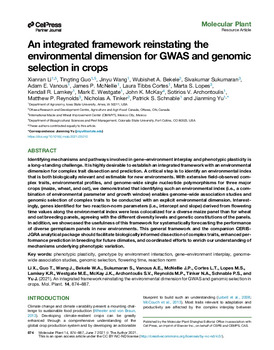Mostrar el registro sencillo del ítem
An integrated framework reinstating the environmental dimension for GWAS and genomic selection in crops
| Creador: | Xianran Li |
| Creador: | Tingting Guo |
| Creador: | Jinyu Wang |
| Creador: | Bekele, W.A. |
| Creador: | Sukumaran, S. |
| Creador: | Vanous, A.E. |
| Creador: | McNellie, J.P. |
| Creador: | Cortes, L.T. |
| Creador: | Lopes, M.S. |
| Creador: | Lamkey, K.R. |
| Creador: | Westgate, M.E. |
| Creador: | McKay, J.K. |
| Creador: | Archontoulis, S.V. |
| Creador: | Reynolds, M.P. |
| Creador: | Tinker, N. A. |
| Creador: | Schnable, P.S. |
| Creador: | Jianming Yu |
| Año: | 2021 |
| URI: | https://hdl.handle.net/10883/21499 |
| Lenguaje: | English |
| Editor: | Cell Press |
| Copyright: | CIMMYT manages Intellectual Assets as International Public Goods. The user is free to download, print, store and share this work. In case you want to translate or create any other derivative work and share or distribute such translation/derivative work, please contact CIMMYT-Knowledge-Center@cgiar.org indicating the work you want to use and the kind of use you intend; CIMMYT will contact you with the suitable license for that purpose |
| Tipo: | Article |
| Lugar de publicación: | USA |
| Páginas: | 874-887 |
| Número: | 6 |
| Volumen: | 14 |
| DOI: | 10.1016/j.molp.2021.03.010 |
| Palabras Claves: | Phenotypic Plasticity |
| Palabras Claves: | Genome-Wide Association Study |
| Palabras Claves: | Genomic Selection |
| Palabras Claves: | Flowering Time |
| Palabras Claves: | Reaction Norm |
| Descripción: | Identifying mechanisms and pathways involved in gene–environment interplay and phenotypic plasticity is a long-standing challenge. It is highly desirable to establish an integrated framework with an environmental dimension for complex trait dissection and prediction. A critical step is to identify an environmental index that is both biologically relevant and estimable for new environments. With extensive field-observed complex traits, environmental profiles, and genome-wide single nucleotide polymorphisms for three major crops (maize, wheat, and oat), we demonstrated that identifying such an environmental index (i.e., a combination of environmental parameter and growth window) enables genome-wide association studies and genomic selection of complex traits to be conducted with an explicit environmental dimension. Interestingly, genes identified for two reaction-norm parameters (i.e., intercept and slope) derived from flowering time values along the environmental index were less colocalized for a diverse maize panel than for wheat and oat breeding panels, agreeing with the different diversity levels and genetic constitutions of the panels. In addition, we showcased the usefulness of this framework for systematically forecasting the performance of diverse germplasm panels in new environments. This general framework and the companion CERIS-JGRA analytical package should facilitate biologically informed dissection of complex traits, enhanced performance prediction in breeding for future climates, and coordinated efforts to enrich our understanding of mechanisms underlying phenotypic variation. |
| Agrovoc: | PHENOTYPIC PLASTICITY |
| Agrovoc: | GENOTYPE ENVIRONMENT INTERACTION |
| Agrovoc: | MARKER-ASSISTED SELECTION |
| Agrovoc: | FLOWERING |
| Datasets relacionados: | https://www.cell.com/molecular-plant/fulltext/S1674-2052(21)00085-X?_returnURL=https%3A%2F%2Flinkinghub.elsevier.com%2Fretrieve%2Fpii%2FS167420522100085X%3Fshowall%3Dtrue#supplementaryMaterial |
| ISSN: | 1752-9866 |
| Revista: | Molecular Plant |
Ficheros en el ítem
Este ítem aparece en la(s) siguiente(s) colección(ones)
-
Wheat
Wheat - breeding, phytopathology, physiology, quality, biotech

